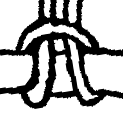©2000 Dan Rusch-Fischer
 The illustrated ring hitch knot is as old as rope. Knots are complications in a flexible body that are classified as to: 1. their form and 2. their use. The ring hitch knot and the true tatting knot are classified as hitches. These knots are made to hold the knot fast to another object or to itself. The half hitch, when made through fabric around a slit for the purpose of preventing the reeving of the cut threads, may be called a buttonhole knot (or stitch). The half hitch when made and turned (i.e., transferred to the carrier) is the true tatting knot. When an alternate pair of half hitches (an 'S' or left half hitch followed by a 'Z' or right half hitch) is made and transferred to the carrier, you have what looks like a ring hitch, but owing to the transfer, is a true tatting 'double knot or double stitch'.
The illustrated ring hitch knot is as old as rope. Knots are complications in a flexible body that are classified as to: 1. their form and 2. their use. The ring hitch knot and the true tatting knot are classified as hitches. These knots are made to hold the knot fast to another object or to itself. The half hitch, when made through fabric around a slit for the purpose of preventing the reeving of the cut threads, may be called a buttonhole knot (or stitch). The half hitch when made and turned (i.e., transferred to the carrier) is the true tatting knot. When an alternate pair of half hitches (an 'S' or left half hitch followed by a 'Z' or right half hitch) is made and transferred to the carrier, you have what looks like a ring hitch, but owing to the transfer, is a true tatting 'double knot or double stitch'.When ring hitches are made in a series over a carrier thread, they simulate a row of true tatting knots.The ring hitch is one of the headers frequently used in macramé (Sir Charles Sedley's poem The Royal Knotter is about macramé and not tatting as is often incorrectly assumed) and is known by many names depending on its use; cow hitch, bale sling hitch, tag hitch, ring hitch, and inaccurately, lark's head knot.
The name lark's head is most commonly seen in works by authors who are not familiar with the classification of knots. This oft-repeated error started with The Book of Knots published in 1866 by either Paul Rapsey Hodge or Frederick Chamier under the pseudonym of Tom Bowling (a name with a nautical sound probably created to impress the sea-loving, but armchair-bound, drawing room Englishman). It was the first book published in English on the subject and it the source of most of the confusion about knots down to this day.
Its inaccuracies are legion, but owing to primagenitur, it is often, unfortunately, cited as the authority on knots. The earliest Scouting manuals quote this 'authoritative source'. It appears that it was essentially a plagarized translation of a French manuscript. The eight most common knots known to the greenest cabin boy were given names that were direct translations of their French names. There were centuries-old English names for each of these knots and none were used. The 'author' obviously had no personal knowledge about knots or their long-standing English nomenclature and to the discredit of his 'scholarship' he didn't even bother consulting somene who had!
As an example, every speaker of English, with a slight familiarity of knots, knows what a granny knot is, but this uninformed plagarist, instead of using the term known and used by every English seaman worth his salt, slavishly translated the French name noeud de faux and called it the 'false knot'.
Every one of these basic knots had long-standing English names and the ring hitch got translated from the French tête d'alouette into the unnecessary and uninformed lark's head. A number of illustrations in this book are backwards! And that is the brief history of the ring hitch, how it relates to the true tatting knot and why it shouldn't be called a lark's head.